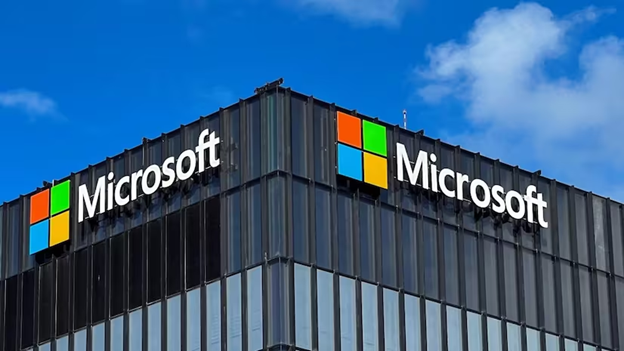A Look Through Microsoft's Windows: What led this company to achieve enormous market domination?
| Hello! Welcome to today’s “Return Driven Strategy (RDS)!” For those of you who don’t know yet, RDS is a pyramid-shaped framework with 11 tenets and 3 foundations. When applied properly, these principles help businesses achieve their organizational objectives. Today, let’s delve deeper into the first out of three foundations of RDS. Read the article below to know why this element is crucial for driving high returns for firms or businesses. |
A Look Through Microsoft's Windows: What led this company to achieve enormous market domination? Having a strong foundation is important in any building or structure. Why?
These are just some of the functions of a strong foundation. Clearly, this part of a building or structure is not something to be taken too lightly. Now, let’s apply that in the context of business strategy… Did you know that every business also needs to have a strong foundation for them to achieve high returns in the long term? We call this foundation the Genuine Assets of a firm.
In the book, “Driven,” Professor Joel Litman and Dr. Mark L. Frigo say Genuine Assets are the “nouns” of business strategy. They are the building blocks (foundations) for creating walls to protect against competition. In their words: “Unique, Genuine Assets, when leveraged appropriately, can be used to create offerings in ways no one else can. This results in sustained returns for decades or more and creates a foundation for unparalleled growth.” Genuine Assets are a means for resisting the natural fade in performance that firms experience whenever competition arises. After all, unique assets make for unique activities and are thereby genuine in nature. In other words, they CANNOT be copied by competitors. BUT! Even so, businesses should always keep in mind that uniqueness in and of itself is NOT inherently valuable. Think about this: The formula always requires a noun and a verb . Of what value is an asset if it does not have the potential to generate future returns? None. This means whether or not it has been explicitly stated, Genuine Assets must lead to wealth creation and fortify a business’ returns . For the next few weeks of “Return Driven Strategy,” we’ll highlight several businesses with Genuine Assets that enable them to stand out in a crowded marketplace. For today, we’ll put the spotlight on Microsoft …
Microsoft created a Genuine Asset with its Windows operating system (OS), which serves as a platform for competitive advantage for different kinds of offerings. In and of itself, the OS was unique for fulfilling otherwise unmet needs. This is evident in the enormous market domination of Windows on computers all across the globe. There are other several factors as to why the Windows OS is a significant Genuine Asset of the tech company:
What else? Early in its strategy, Microsoft utilized a unique, non-copyable OS and its large user base to push through applications, which could “talk” to each other relatively easily, and many commands like “cut-and-paste” were identical keystrokes across the systems. As a result, Word overtook WordPerfect in word processing software. Excel overtook Lotus 123 in the spreadsheet market. PowerPoint replaced other previously used graphic presentation apps. The Access database software became dominant in its category. In all of these areas, the first movers lost . Customers were willing to forego the bleeding edge of functionality of WordPerfect, Lotus 123, and others in exchange for more basic functionality that could be seamlessly used together in the Windows ecosystem. See? In the case of Microsoft, the development, management, and leveraging of its Genuine Assets have formed the foundation of its success. In fact, the company’s history of cash flows is one of the best ever seen in the industry! That’s why Microsoft is one of the “Marvels” of Return Driven Strategy. Through its unique and legally non-copyable OS, the company succeeded in fulfilling the otherwise unmet needs of more and more targeted customer groups. What about you? Do you already know your business’ Genuine Assets? If you don’t know yet, now is the time to figure it out! You’ll see, with such assets, you’ll also be able to achieve success like Microsoft—gaining a competitive edge, leveraging an effective ecosystem, innovating constantly, and maintaining a dominant position in the industry. — If you’re looking to gain a better understanding of Return Driven Strategy and Career Driven Strategy, we highly recommend checking out “Driven” by Professor Litman and Dr. Frigo. Click here to get your copy and learn how this framework can help you in your business strategies and ultimately, in ethically maximizing wealth for your firm. Hope you found this week’s insights interesting and helpful. EXCITING NEWS AHEAD The world of work has shifted, and there’s no going back. The barriers to entry have never been lower for talented professionals to work independently, and today’s massive external workforce is hardly a pandemic-produced fad. Business owners can only survive in the new work landscape by partnering with this deep talent pool. With decades of experience in both small-business entrepreneurship and executive management at PwC, I truly believe that the future of work is independent. With that, I’m happy to share with you that my book, co-authored with Walter Scott Lamb, is now available for pre-order on Amazon! Free Birds Revolution: The Future of Work & The Independent Mind This is an essential read for both independent professionals and corporate executives. Here, we provide educational and practical guides to unpack the ever-growing workforce and offer you crucial ways to become a client of choice. Click on the link above to pre-order your copy. Let this book help you future-proof your career and organization in the new world of work. Stay tuned for next Tuesday’s Return Driven Strategy! The talent crunch is real and each day, it’s becoming harder and harder to solve the widening skills gap. Learn more about the importance of skills in the world of business and work in next week’s article! |

Miles Everson
CEO of MBO Partners and former Global Advisory and Consulting CEO at PwC, Everson has worked with many of the world's largest and most prominent organizations, specializing in executive management. He helps companies balance growth, reduce risk, maximize return, and excel in strategic business priorities.
He is a sought-after public speaker and contributor and has been a case study for success from Harvard Business School.
Everson is a Certified Public Accountant, a member of the American Institute of Certified Public Accountants and Minnesota Society of Certified Public Accountants. He graduated from St. Cloud State University with a B.S. in Accounting.




